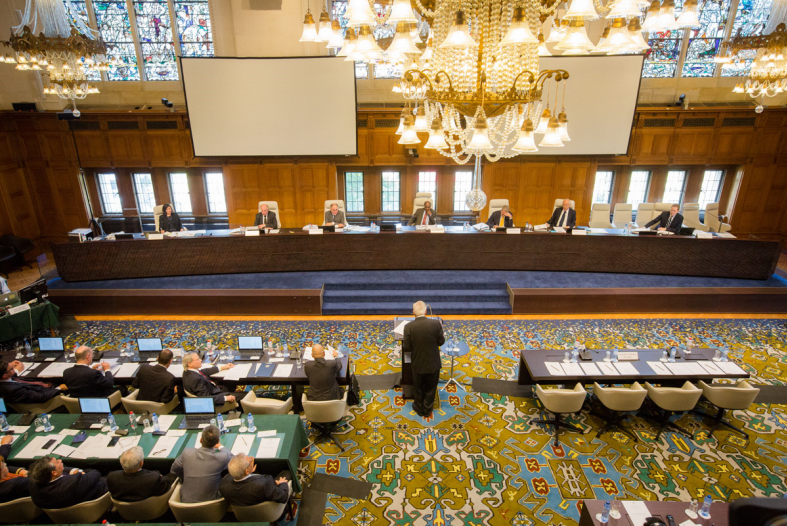A LOOK at some recent key developments in the South China Sea, where China is pitted against smaller neighbors in multiple disputes over islands, coral reefs and lagoons in waters crucial for global commerce and rich in fish and potential gas and oil reserves:
Tribunal decision on July 12
Five judges of a U.N. tribunal will deliver July 12 their landmark ruling on South China Sea disputes — and Beijing is already dismissing a potentially unfavorable outcome.
The Permanent Court of Arbitration will decide on a 2013 case filed by the Philippines, which asked the court to declare China’s territorial claims that encompass most of the South China Sea invalid because they infringe upon the country’s own 200-mile exclusive economic zone.
The Philippines turned to the tribunal after China effectively seized control of Scarborough Shoal, a tiny uninhabited reef off Luzon Island, following a tense standoff with Philippine vessels. Since then, China has built eight artificial islands on top of land features, some of which are normally submerged at low tide, and constructed airfields and military installations.
Chinese Foreign Ministry spokesman Hong Lei said that the tribunal was “established on the basis of illegal conduct and claims of the Philippines,” and has no jurisdiction over the case.
The United States called on China and rival claimants to avoid provocations and exercise restraint, and use diplomacy.
New Philippine leader tackles China
Philippine President Rodrigo Duterte took oath as diplomats and officials looked for clues on how he intends to deal with China after the U.N. tribunal’s ruling. Some hints came on his first day in office.
During a Cabinet meeting Thursday, Foreign Secretary Perfecto Yasay said that he was not in favor of issuing a strong statement if the tribunal rules in the Philippines’ favor. He said that China could potentially “dig in and put us to a test.” If that happens, he said, “there is no point for us to yell.”
China sees an opening in Duterte and wants to settle the issue with the Philippines directly, without outside arbitration. Duterte’s predecessor Benigno Aquino III angered Beijing when he initiated the arbitration and invited large numbers of U.S. forces back to the Philippines.
According to a Philippine official, the Chinese ambassador has worked hard to repair damaged relations with Manila and told Filipino diplomats Beijing would extend an invitation to the new president to visit China within the next six months.
Duterte himself said he wants to open direct talks with China.
He said he asked U.S. Ambassador Philip Goldberg whether Washington will support the Philippines in case of a possible confrontation with China. Duterte suggested that a 1951 Mutual Defense Treaty between the allies does not automatically oblige Washington to immediately help the Philippines.
He said he asked Goldberg in a recent meeting, “Are you with us or are you not with us?” adding that Goldberg responded, “Only if you are attacked.”
In Washington, the State Department said the U.S.-Philippine alliance is “ironclad” and the U.S. would stand by its treaty commitments.
Asean remains split
Cambodian Prime Minister Hun Sen, a China ally, spoke against the Permanent Court of Arbitration, further dividing the 10-member Association of Southeast Asian Nations.
Speaking during the ruling party’s anniversary, Hun Sen said he was against “any declaration by Asean to support the decision of the Permanent Court of Arbitration in relation to the South China Sea disputes.”
“Efforts by some countries outside the region to mobilize forces against China would bring negative impacts on Asean and peace in the region,” he was quoted as saying.
Last month, Cambodia and other pro-China Asean members Laos and Myanmar withdrew their support for a tough statement by Asean foreign ministers to avoid offending China, which hosted the meeting. Initially, all the Asean foreign ministers agreed on the text of the joint statement expressing concern that the South China Sea disputes eroded trust and increased tensions and could undermine peace and security.
US beefing up forces in the Pacific
With an eye toward the South China Sea, U.S. forces are planning to deploy a second Navy-Marine amphibious group in the region beginning in 2019.
According to Lt. Gen. John Wissler, commander of Marine Corps Forces Command, the presence of the second Amphibious Ready Group in the southern Pacific — in addition to Japan-based forces in the East China Sea — would allow multiple 90-day patrols covering the entire Asia-Pacific region.
China has accused Washington of turning the South China Sea into a powder keg and says the U.S. should stay out.
Last word
“The (United Nations Convention on the Law of the Sea) gives us the exclusive right over 200 (nautical miles). If I go there using that privilege of mine, would that be an attack against China or an offense against China?” said Philippine President Rodrigo Duterte.
RELATED VIDEOS
